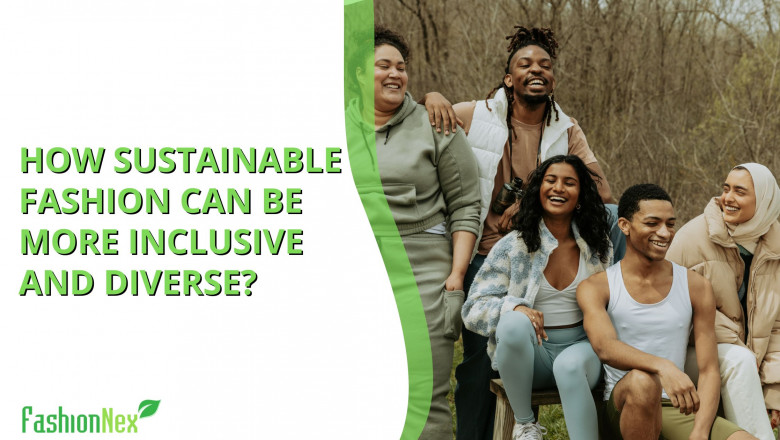views

Sustainable fashion describes outfits and accessories that are created, distributed, and worn in a way that is ethical in terms of both the environment and society. Due to the fashion industry's infamously bad environmental effects and unethical labor practices, sustainability has become increasingly important to the sector. Growing awareness of the importance of inclusivity and diversity in sustainable fashion has occurred recently.
Inclusion and diversity address the need for representation and access to sustainable fashion for all people, regardless of their origin or identity, whereas sustainability concentrates on the environmental and social effects of fashion. This essay will examine ways to increase the diversity and inclusivity of sustainable fashion.
The Current State Of Inclusivity And Diversity In Sustainable Fashion
Despite the growing importance of inclusivity and diversity in sustainable fashion, there are still significant gaps in representation and accessibility. One major issue is the lack of representation of diverse individuals in sustainable fashion campaigns and marketing. Many sustainable fashion brands tend to use models who fit traditional beauty standards and fail to include individuals from diverse backgrounds, ethnicities, and body types.
Additionally, limited size ranges and the availability of sustainable fashion for plus-size and petite consumers is a significant issue. Many sustainable fashion brands only offer a limited range of sizes, leaving out a significant portion of the population. This lack of inclusivity extends to certain cultures and ethnicities, as sustainable fashion options may not be readily available or cater to their specific styles and needs.
Overall, sustainable fashion must address the need for inclusivity and diversity in all aspects of the industry to create a more equitable and accessible future for all.
Related- Sustainable fashion movements around the world
Addressing The Problem: How Sustainable Fashion Can Be More Inclusive And Diverse
There are several tactics the industry may use to address the lack of inclusivity and diversity in a sustainable fashion.
Beginning collaborating with different designers, models, and influencers can support the development of campaigns and collections that are more inclusive and diverse. This may entail collaborating with designers and models from various communities and cultures and showcasing them in promotional materials.
Second, to create more inclusive and accessible sustainable fashion, broadening size ranges and availability is essential. To serve all customers, especially those who are plus size and tiny, sustainable fashion manufacturers should work to offer a wide selection of sizes.
Thirdly, merging conventional and cultural fashion customs into sustainable fashion can contribute to the industry's diversification and inclusiveness. Cultural variety can be celebrated and respected through the use of traditional textiles, patterns, and designs from many cultures.
Last but not least, making sustainable fashion more accessible in underdeveloped nations can provide opportunities for regional craftspeople and promote sustainable practices in these communities. This may entail establishing fair trade alliances and making investments in regional production facilities to increase employment prospects and advance sustainable practices.
Overall, these tactics can contribute to a future that is more egalitarian and accessible for everyone by increasing diversity and inclusivity in sustainable design.
Benefits Of Inclusivity And Diversity In Sustainable Fashion
The sustainable fashion business and customers may both benefit from inclusivity and diversity.
Firstly, improved presence and visibility for marginalized communities can help to establish a more inclusive and equitable industry. Sustainable fashion can celebrate and promote diversity while empowering underrepresented groups by showcasing various people in campaigns and collections.
The sector may access new markets and consumers by being inclusive and diverse, which is the second benefit. By responding to varied demands and trends, sustainable fashion may generate a wider consumer base and improve profitability.
Thirdly, encouraging a fashion sector that is more morally and environmentally aware. Sustainable fashion companies can show that they are committed to using ethical and responsible business processes by putting a high priority on inclusivity and diversity. This could serve as an example for other companies, helping to create a more moral and environmentally friendly fashion sector overall.
Overall, diversity and inclusivity are essential for building a more just and open future for sustainable fashion. Sustainable fashion may advance its ethical, conscientious, and receptive nature by embracing variety and inclusivity.
Challenges And Solutions For Implementing Inclusivity And Diversity In Sustainable Fashion
Although inclusivity and diversity sustainably offers many advantages, some difficulties must be overcome. Following are some obstacles to inclusiveness and diversity implementation in sustainable fashion, along with potential solutions:
The initial action is to get over prejudices and stereotypes in the fashion industry. Marginalized cultures have historically been barred from the fashion business because of their rigid beauty standards. By developing more inclusive campaigns and marketing materials, sustainable fashion companies may actively endeavor to confront and challenge prejudices and stereotypes.
Second, talk about the expense and resources required for inclusive sustainable fashion. Making sustainable fashion more inclusive and varied would demand additional resources since it currently involves significant investment in materials, production, and distribution.
Thirdly, cultivating an encouraging and welcoming atmosphere inside sustainable fashion businesses. Sustainable clothing companies must have a welcoming and inclusive working culture that values diversity and promotes a sense of community. This may entail employing hiring procedures that give diversity and inclusion a high priority, offering training on these topics, and establishing internal committees to advance inclusivity and diversity.
To establish a more inclusive and diverse future for fashion, it will be necessary for the sustainable fashion sector to work together to address these issues. By doing this, we can develop a fashion sector that is fairer and more environmentally friendly and that benefits all people and communities.
Related- Collaborations Between Fashion and Technology for Sustainable Solutions
Fashionnex Final Words
In conclusion, openness and diversity are essential for developing a fashion business that is more just and sustainable. Sustainable fashion companies may broaden their customer base, access new markets, and promote an ethical and conscientious business by embracing inclusivity and diversity.
While integrating inclusivity and diversity might be difficult, brands can overcome these difficulties by addressing prejudices and stereotypes, dedicating resources, and developing a welcoming workplace environment. As buyers, we can also make a difference by supporting fashion companies that value diversity and inclusivity in their business operations.
To establish a more open, just, and sustainable future for fashion, the sustainable fashion sector must place a high priority on inclusivity and diversity.











Comments
0 comment